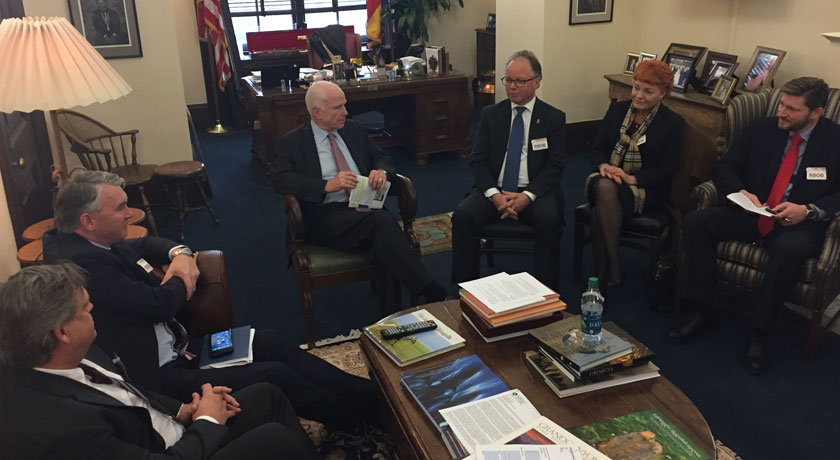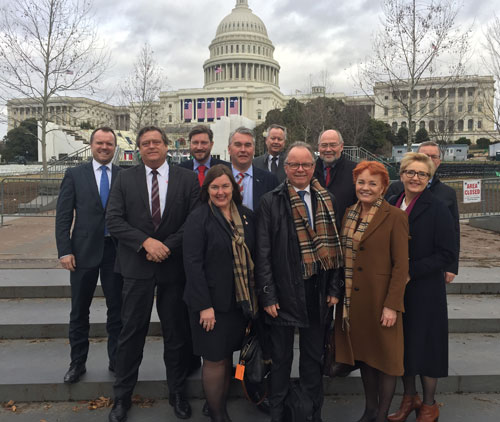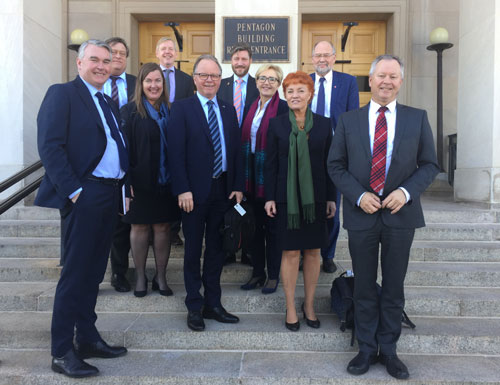
The Standing Committee on Foreign Affairs and Defence had a very constructive meeting with Sen. John McCain. Photo: Storting.
Storting’s Standing Committee on Foreign Affairs and Defence visits Washington
The Storting’s Standing Committee on Foreign Affairs and Defence, led by Øyvind Halleraker, visited Washington from 23 to 26 January 2017, only a few days after the inauguration of President Trump.
Among the main issues discussed during the visit were US foreign policy, including the relationship to Europe and NATO, the relationship to Russia, the fight against ISIL and the conflict in Syria.
The objective of the visit was to gain insight into the changes being prepared in US foreign policy, security policy and defence policy as well as to advance Norwegian points of view in key areas and develop contacts with the new administration. The visit also provided a good basis for the upcoming consideration of the white paper on Norwegian foreign policy choices as well as the white paper on development policy, both of which the committee will consider during the spring session.

The Standing Committee on Foreign Affairs and Defence at Capitol Hill. Photo: Storting.
Meetings with influential players
“We have had three very full days in Washington,” said Øyvind Halleraker (Conservative Party), the committee’s First Vice Chair and head of the delegation visiting Washington.
“The committee has met many central actors associated with American foreign and security policy. They have all been open and direct about areas likely to receive special emphasis by the new administration. We have also communicated Norwegian policy and our expectations to the new administration.”
In Congress, the Standing Committee on Foreign Affairs and Defence met the Chairman of the Senate Committee on Armed Services, Sen. John McCain, and three representatives of the Norwegian Friendship Association in the House of Representatives.
The committee held additional meetings at both the State Department and the Pentagon. One was with the Special Presidential Envoy for the Global Coalition to Counter ISIL, Brett McGurk, and members of his staff.
The committee also met analysts from a number of well-established research organisations, think tanks and universities, including the Brookings Institution, the Carnegie Endowment, the Atlantic Council, the Heritage Foundation and the Center for Transatlantic Relations at Johns Hopkins University. The committee concluded by meeting with representatives of the World Bank.
The committee also met Norwegian officers associated with the jet fighter project, including F-35 flight personnel, and were briefed on the status of the programme and the aircraft already delivered to Norway.
“Learning about the views of American officials at a range of levels, both in political posts and within the federal administration, was very useful. In all the meetings it was emphasised that even in the United States there is a great degree of anticipation regarding the new Trump administration. During our time in Washington we covered many different issues, with special emphasis on highly relevant security policy questions related to NATO’s role in the future, relations with Russia, the fight against ISIL, and the situation in the Middle East and Syria in particular,” said Mr Halleraker.
The two per cent target
In relation to NATO, it was underscored in all the meetings that President Trump will be very clear that member countries must now deliver on the two per cent target that has been adopted, and that everyone must contribute substantially to alliance burden sharing. The committee’s members were keen to point out that Norway has always been a reliable NATO contributor. It also assumes genuine responsibility for NATO’s northern flank, an important example of the kind of burden sharing Trump seeks to address. It was also stressed that the newly approved long-term plan for the Norwegian Armed Forces included decisions on key materiel procurements regarding the number of fighter jets, investments in new surveillance aircraft, new submarines, and important intelligence capacities.

The Standing Committee on Foreign Affairs and Defence at the entrance to the US Department of Defence, the Pentagon. Norway’s ambassador to the United States, Kåre Aas, also attended the meetings. Photo: Storting.
Russia
Another recurring topic in the meetings was Russia, including President Trump’s statements on improving the US relationship with Russia and his positive statements regarding President Putin.
“It has been very useful for the committee to hear the clear and sincere opinions held by people with different vantage points around Washington on the President’s statements relating to Russia. For the committee, it has been important to point out that for Norway, as a neighbour of Russia, it is important to be clear and predictable in relation to Russia. And that Norway, furthermore, is fully in line with the EU on the restrictive measures applied to Russia as a result of the annexation of Crimea and the hostilitiesin Eastern Ukraine. At the same time, the committee noted that dialogue and cooperation in the north are in the interests of both Norway and Russia. There are many examples of the effectiveness of such cooperation, and we ought to continue with it,” Mr Halleraker concluded.
Participants
The following members of the committee participated in the trip: Øyvind Halleraker, First Vice Chair (Conservative party); Christian Tybring-Gjedde, Second Vice Chair, (Progress Party); Marit Nybakk (Labour Party); Svein Roald Hansen (Labour Party); Trond Helleland (Conservative Party); Harald Tom Nesvik (Progressive Party); Liv Signe Navarsete (Centre Party); Kåre Simensen (Labour Party); and Elin Rodum Agdestein (Conservative Party).
Last updated: 30.01.2017 09:45